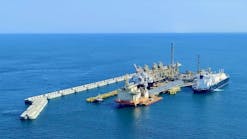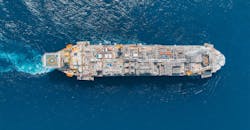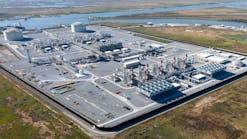E.F. Durkee, M. J. GerrardIn these days of work stations, 3D seismic, geologists who have never heard of a Stebinger drum, satellite applications, directional drilling, and an offshore oil industry of unbelievable sophistication and technology, the authors present here some recent observations and scenes for the record. This is a record about a segment of the oil scene of which most of the world's oil industry members have not seen or are aware. Some may not be able to visualize it.
In November 1996 and in February 1997, the authors of this article had the privilege to make field trips to the Chindwin basin region of northwest Myanmar (Burma). Although numbers of oil men and geologists have visited this region the past 100 years or so, the number of such visitors is but a small percentage of the total in our field. Nowhere in our studies have we seen documented the scenes that were observed and photographed there recently and as reported upon here.
About 150 miles northwest of Mandalay (Fig. 1 [180,834 bytes]), along the Myittha River, a tributary of the Chindwin River between the towns of Kalemyo and Kalewa (Lat. 23° 17' N., Long. 94° 18' E.), a thriving local oil industry exists. This industry features exploration, drilling, oil production, transportation, refining, marketing, and distribution.
The operation is not related to Myanmar Oil & Gas Enterprise.
Exploration methods
Exploration as such largely includes the location and reporting of oil seeps and mud volcanoes carrying oil and gas to the surface.This could be considered as simply "playing the trend" along the Eocene outcrop belt extending along the west margin of the Chindwin basin. The extent is some 150 miles from the vicinity of Gangaw (100 miles south of Kalemyo) to the region west of Mawlaik to the north.
Geologically, it is interesting to note that that oil is being produced from steep (40°+) easterly dipping shales and sandy shales along the west margin of the basin.
In this region, especially west of Kalewa, oil is being produced from dozens of wells ranging in depth from a few tens of feet to as much 300 ft. The nature of the trapping mechanism is not explained. Perhaps it is a case of deeply buried oil source beds being uplifted, tilted, and exposed at the surface or near the surface.
Drilling practices
Wells are drilled with small bamboo derricks that generally consist of four bamboo poles about 10 ft high (Fig. 2). These are joined at the top with rope, wire, or vine and generally have a lateral rail of bamboo near the top.On that bamboo rail is placed a couple of cross bars that support a 3-4 in. sheave over the proposed hole, over which the "drilling-line" (3/4 in. rope) is run from the downhole bit to the hands of the "draw-workers" (two or three young men).
The rope is attached to a bit assembly. The bits appear to be pieces of 2 in. pipe about 18 in. in length (Fig. 3) that are in turn welded to a piece of iron rod, not unlike segments of sucker rods about 6 ft long. This is attached to the drilling line and might weigh up to about 50 lb. The bit assembly is then raised and dropped by the men pulling on the drilling line.
In this fashion a spudding action occurs with a driller not unlike those of olden time cable tool rigs with his hand on the line "feeling" the way things are going down hole.
The driller also continues to drop plastic bags filled with water down the hole (Fig. 4). These break and mix with the cuttings, forming a mud that packs up into the bit, which is then brought to the surface and cleaned out prior to commencing another run.
These wells reach depths of 50-200 ft over a period of days. Some wells have a short joint of surface pipe consisting of 4 in. blue polyethylene water pipe. Others are not cased.
From the early days of the oil industry along the Canadian shore of Lake Erie to the causeways of the Russians onto the Caspian Sea at Baku, or the platforms in Lake Maracaibo, drillers felt their way into the water environments of the world to explore for oil.
This area is not to be left behind. On the south bank of the Myittha River west of Kalewa a new "offshore platform" had been constructed, and a well was planned to be drilled there, too (Fig. 5).
Producing oil
Seepage of oil into the bore holes is reported to vary from a few gallons to as much as 20 gal/day in exceptional wells.Oil is baled with a short section of 3 in. ? diameter of polyethylene pipe (Fig. 6) and poured into buckets (Fig. 7) which are then emptied into barrels or plastic "jerry cans" for transport to the "refineries."
When a well is depleted, the rig is moved over about 10 ft and a new hole is drilled. When the authors visited the active drilling field west of Kalewa, dozens of wells were being drilled and produced (Fig. 2).
Transportation
Perhaps one of the more unique sights on the field are the many women in the teenage to 30 years old range, as well as some young boys, that form the "pipeline" from the wells to the refineries on the north side of the Myittha River along the Kalemyo-Kalewa road.These workers carry five to six gallon plastic jerry can-like back packs filled with crude oil. In some instances they walk a few miles from the wells to the south bank of the river, where they are ferried in large motor launches to the north bank, and then climb up the steep north bank to a terrace level near the road on which the refineries are located. The motor launches can accommodate 20 or more backpackers.
Figs. 8-11 illustrate various aspects of this phase of the operation. This human pipeline is on the move continuously like a string of ants during the daylight hours. Morale appears high, with lots of smiling faces (Fig. 10), and it is reported the young ladies can earn the equivalent of about $1/day.
Refining
The Kalewa crudes range from 28 to 35° API, vary in color from dark brown to light green, and are slightly paraffinic.Analyses by the Australian Geological Survey Organisation in Canberra indicate the oils are originating in continental source beds with coal and carbonaceous content. The refining system itself is presumably similar to that used in the central Ayeyarwady (Irrawaddy) basin oil fields during the late 1800s.
Figs. 12-16 show various aspects of some of the Kalewa refineries. These are essentially a 5 bbl steel caldron or tank encased in brick and underlain by a firebox that burns wood. A batch of 5 bbl of raw crude oil is loaded into the top of the tank and brought to a boil with a wood fire.
As the oil condenses it escapes at the top of the boiler into a "product line," which in turn passes laterally through a number of barrels that are oriented horizontally, with a window cut in the top of each barrel which is kept filled with cool water. As the condensate cools it liquifies, and a final product of diesel is captured in barrels (Figs. 17 and 18). This diesel is widely used in the Chindwin area as fuel for trucks, light plants, and engines on river craft.
For every 5 bbl refined, about 4 bbl of product are produced. Most of the refineries have a side port at the base of the caldron from which coke and residue are withdrawn from the base of the tank after a refining run. In some places it was said that the coke is ground and mixed with low grade Eocene coal mined nearby. Others do not know what to do with it and throw it away or stockpile it.
It is estimated at the six refining sites west of Kalewa that perhaps 10-20 b/d or more of diesel are produced.
Marketing, distribution
The final product is moved in barrels via bullock carts (Fig. 19), trucks, and boats up and down the Chindwin River (Fig. 20).This cottage oil industry may seem an anchronism, but it is a very real and vital aspect of commercial life in Northwest Burma, just as the industry is throughout the world. It is a testimony to the spirit, ingenuity, and ambition of the people of the industry of the Kalewa region.
Conclusion
This oil occurrence testifies to the potential oil source rocks of the Eocene in the Chindwin basin.Forty miles to the northeast of Kalewa on the east flank of the Lotha syncline (Kalewa is on the west flank) lies the site of Myanmar's once upon a time most remote oil field. This is Indaw field, discovered in 1918, which produced 1.5 million bbl of oil from shallow (800-1,200 ft) discontinuous Miocene sandstones. The field supported a 30 mile, 4 in. pipeline from Indaw to a small refinery at Pantha on the Chindwin River. The field produced until 1942, when it was destroyed before the advance of the Japanese Army.
It seems likely, as postulated by some earlier workers (Myanma Oil & Gas Enterprise, 1974 and Yukong, 1990) that the oil potential of the Eocene at Indaw makes the structure a good candidate for a giant discovery. The Indaw oil likely migrated upwards from Eocene source rocks or reservoirs along a major thrust zone and associated faults into the shallow Miocene reservoirs.
The Indaw anticline is a surface feature of beauty. Its area of closure is about 45 miles long and four to five miles wide. It has about 250 sq miles of areal closure.
Seismic data obtained by Yukong in 1989-90 demonstrate nearly 2,000 ft of vertical structural relief in an east-west direction on seismic reflections from about 14,000 ft and deeper. Reservoirs at this depth could be associated with oil source rocks seen in the outcrop belt to the west, including the Kalewa oil fields.
For a truly fascinating account with photographs, of the oil industry of Burma in the 1920s to mid-1930s, including a chapter on Indaw, the reader is recommended to the book A Geologist in the Service of the Raj, by Cecil Thomas Barber. Most exploration people as well as other oil industry members interested in the history and development of the modern industry will revel in Barber's spell as he narrated his observations of the oil industry in Burma in 1923-35.
The Authors
Ed Durkee has spent nearly 45 years in oil and gas exploration. He worked in the U.S. Rockies and Midcontinent with Gulf Oil Corp. before moving international with American Overseas Petroleum Ltd. Since 1971 he has been associated with several independents and consulting, working on all continents except Antarctica and in most of the world's principal oil provinces. He has since 1987 been largely working on the Pacific Rim in New Zealand, Papua New Guinea, and most of Southeast Asia. He heads E.F. Durkee & Associates Inc. in Manila and is a director of Pacrim Energy NL, Brisbane. He holds geology degrees from the University of Wyoming.
Jerry Gerrard has spent 40 years in exploration in Australia and overseas. He started in exploration and development geology with American Overseas Petroleum and drilling engineering, the latter after University of Texas post graduate studies that led to his appointment as Beaver Exploration Group managing director. Later he managed shelf drilling in the Bass Strait and Northwest Shelf and drill ships for Global Marine in international waters. He was general manager of Richter Drilling in China, Indonesia, and Papua New Guinea. More recently, based in Brisbane, Queensland, he has served as a consultant drilling supervisor for MIM, Petroz, Cophil, and Pacrim. He is a science graduate of Sydney University.
Copyright 1997 Oil & Gas Journal. All Rights Reserved.



